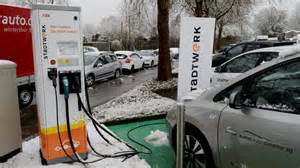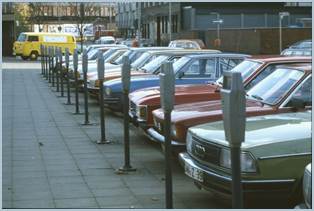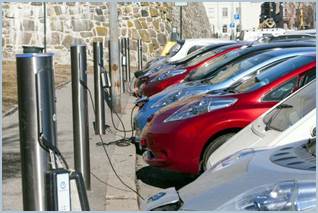Advantages of wireless inductive charging
Apart from the comfortable daily use of wireless
power transfer this technology delivers numerous additional advantages
for the users. There are advantageous features for the user itself but
also for the energy provider. Within experts the wired charging
technology is a main aspect kept responsible for preventing the broad
acceptance of electro mobility and wireless charging will overcome this
issue.-
Comfort
The value of such a comfort becomes even more obvious if charging needs to be executed under adverse weather conditions. Situations during winter are shown in the following figure.

-
Installation appearance in urban environment


With the installation of wired charging columns this type of unwanted street furniture returns to the cities.
This is different by using the flush mounted wireless power transfer. All technical equipment is placed underneath the street surface and is optically barely visible.
Beside the unattractive view of street furniture it has direct practical and financial disadvantages. Charge columns are as well as parking meters obstacles for the street traffic. As such the risk of collisions and other damages is quite high and causes expenses for the operators of the equipment. This is quite different by using the flush mounted wireless power transfer enabling a robust and service free operation.
-
Obstacle free installation
Pedestrians can cross the space without watching their way, a feature being mandatory for public spaces. Also, during charging despite the vehicle itself no additional obstacle is caused due to the charging technology like it is the case by using the connection cable between a charge column and a vehicle.
-
Protection against Vandalism
Furthermore, copper cables are quite often stolen due the value of the copper. Mechanical locks within the plug do not prevent the theft as cutting the wire from the plug can easily be done with appropriate tools. Due to the cable costs such thefts lead to considerable financial damage. The design of wireless technology prevents such thefts.
-
Electrical safety
As wireless technology inherits no electrical connected parts at the surface electrical risks do not occur to end users, the installation of ground fault circuit interrupters is not necessarily needed and robustness and service free operation is enhanced.
-
Availability
Due to the uncomfortable task to plug a wired electrical vehicle to the grid users tend to take this action only if it is unavoidable. This is the case if the battery is almost empty. Therefore, the battery is often stressed with deep discharge and charge cycles with negative effect to the life time of the battery which is dependent of the deepness of the discharge. With wireless charging the battery will be recharged after each travel. Thus, the battery is stressed just with the least possible deepness of discharge. Enhancement of the lifetime is a cost saving effect justifying investments to the wireless technology. Furthermore, the vehicle is always in the highest possible charging state providing the best possible availability to the user.
Utility providers are interested to use vehicle batteries to function as a controllable load in order to receive fluctuating energy at times of high green energy generation. Most often such functionality has barely negative effects to the end user as very often the charging times are much shorter compared to the parking time. (As long the battery is only used as a controllable load and is not been discharged there is also no negative effect to the life time.) Certainly such functionality is only possible, if the car is actually connected to the grid. Due to the inconvenience of plugging a car charged by wire is quite often not connected and therefore its battery capacity not usable for the utility. cannot serve as a controllable load. Therefore, the automatic connection of wireless technology is an enabling technology for smart grid functionality of vehicle batteries.